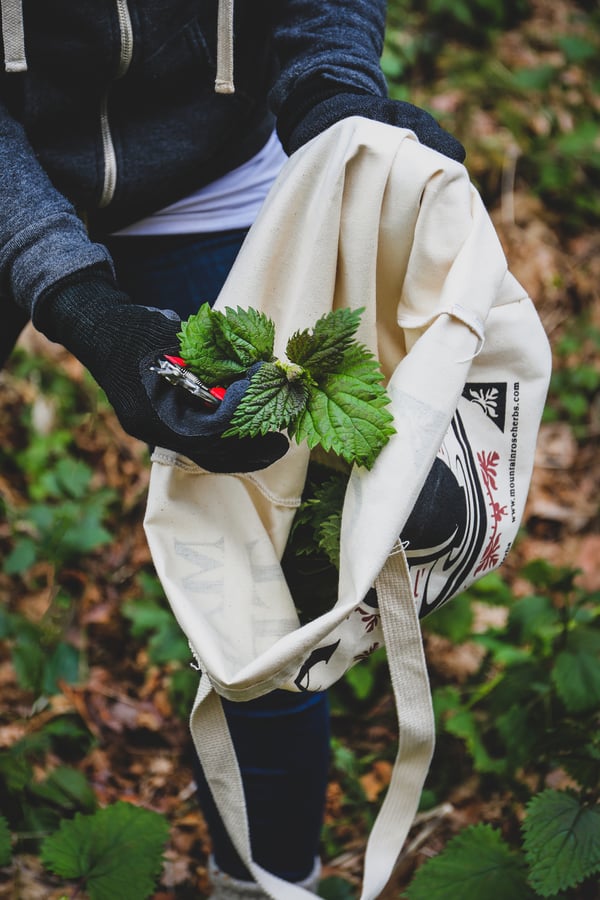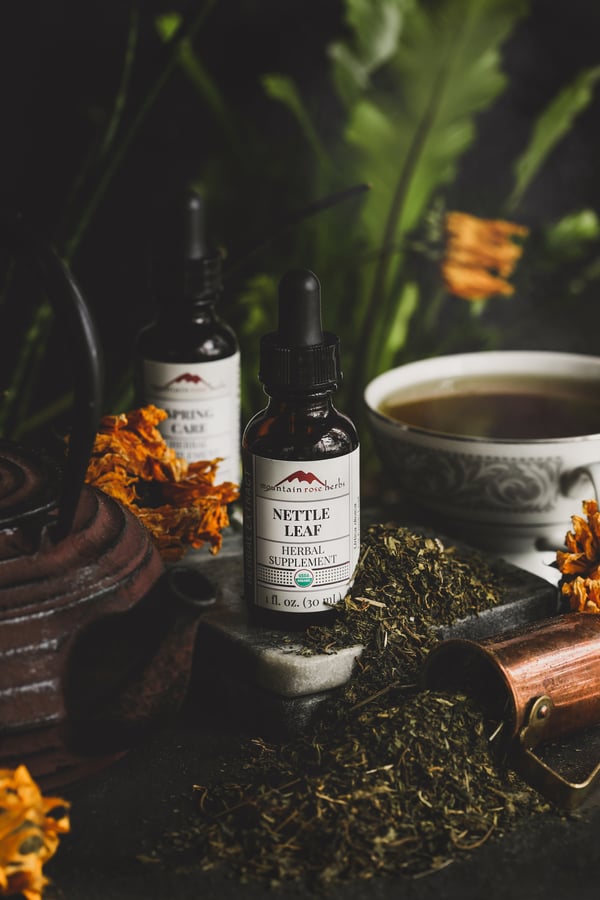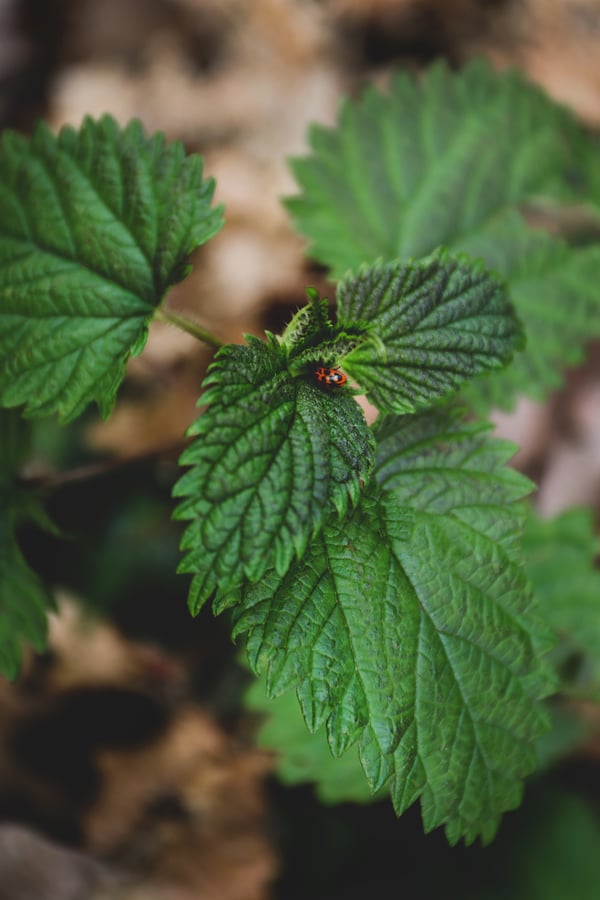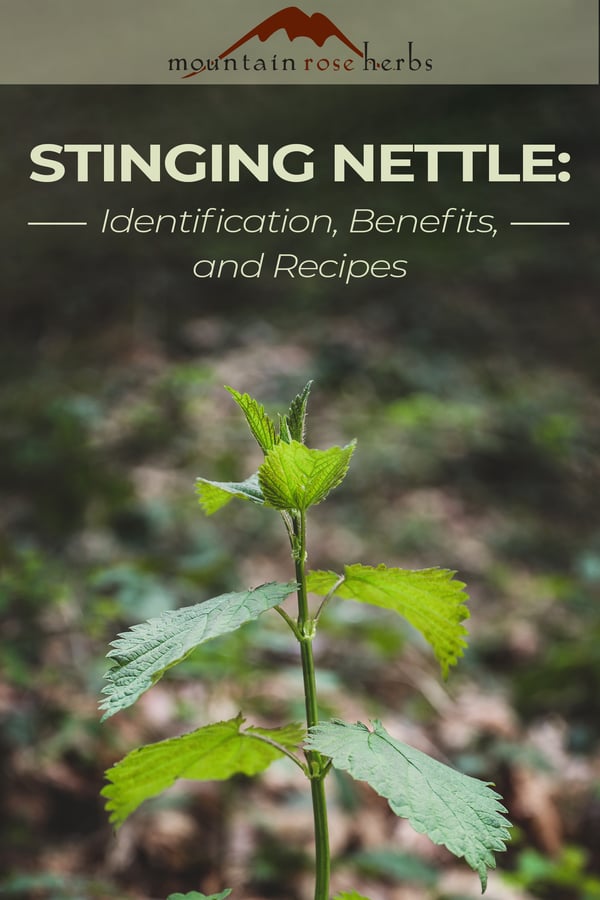It’s late winter in the Pacific Northwest and signs of spring are already starting to show themselves. I’ve always enjoyed this time of year, the excitement of witnessing the Earth waking up from her wintertime slumber and the feelings of hope that brings. But despite the heartfelt joy, I often find myself struggling to move from the slower pace of winter hibernation to the quickening energy and longer days full of garden prep, housework, and other to-dos that piled up. Thankfully, I need to look no further than my trusty green ally, nettle, for support during this transition.
How to Identify Stinging Nettles
Urtica dioica may be most known for its sting which can strike the unsuspecting hiker or wildharvester, leaving a stinging tingle and accompanying red rash. This response is caused by hairs on the leaf and stem which contain formic acid. However, stinging nettle can be identified before a sting is ever experienced! Nettles tend to grow in patches in moist ecosystems including marshy habitats and along streams. Growing 2 to 8 feet tall, nettles are dark green in color with opposite, serrated, heart-shaped leaves. Nettle’s square stem could be confused for a member of the mint family; however, this herbaceous perennial belongs to the Urticaceae family.
Nettle seems to peak its head up from the damp, cool earth just as the transition into early spring commences. I love looking for the bright green budding leaves emerging on some of my favorite local hikes, noting their growth compared to last year and whispering words of encouragement and gratitude as I go along. I know that in a couple months, I’ll be returning to some of these well-established stands to responsibly (and carefully) harvest the dark, green leaves.
Health Benefits of Stinging Nettle
Not only do nettles fortify my mental and emotional body as a harbinger of spring, but they also nourish my physical body with bountiful minerals and plant protein. Nettles are especially helpful after long periods of stress, like perhaps the winter holiday season or living through a pandemic for the last couple of years. If you do take nettles often and are constitutionally on the drier side like me, try adding some mucilaginous herbs to your daily brews like marshmallow leaf or malva.
Nettle helps to maintain upper respiratory health* and can even be part of a comprehensive program for many folks dealing with seasonal allergies. Considered a tonic herb, nettles are convenient to take in herbal preparations such as extracts, capsules, and infusions. The entire plant holds wellness-supporting properties, from leaf to seed to root.
Nourishing, with an affinity for the liver, this giving friend supports healthy urinary function and has a mild diuretic action*. The leaf is also used topically in skin and hair care formulations, including this hair rinse recipe. Historically, stinging nettle was used in urtication or the intentional flogging of the plant onto bare skin to stimulate blood flow. Not only could this method be useful in “waking up” the body after a long winter’s rest but may also help in stimulating sensations in the muscles for those brave enough to try.
A little less painful is nettle’s other historic use as a fiber commonly woven into cloth and cordage. Stinging nettle leaf has even been utilized as a vegetarian option to traditional rennet in cheese making.
Nettle Tea and Food Recipes
Not all nettles are created (or grown) equally, and I rather enjoy the natural variation found from plants growing in different bioregions. For example, the domestically cultivated nettles we offer at Mountain Rose Herbs brews a bright green and has a lighter flavor that I like to add in herbal tea blends. Comparatively, our European, wildcrafted nettles are darker in brew and taste, making them enjoyable as an infusion on their own.
try these time-tested Nettle tea recipes from our blog:
- How to Make Nourishing Herbal Infusions
- Mental Fog Lift Tea
- Meditation Tea Blend
- Calm Spirit Tea Recipe
Another beauty of nettles is that its rich, umami, and slightly salty flavor profile pairs well with many culinary herbs and is also a complementary ingredient in a variety of foods.
Try these nettle-inspired dishes:
- Homemade Pesto with Nettles
- How to Make Homemade Tortillas with Nettles
- Nettle Leaf Buttermilk Biscuits
- Kale and Nettle Chip Recipe
To me, nettles are reminiscent of a mother figure or big sister. Someone who is nourishing, prolific, and giving, but also isn’t afraid to put you in your place when you need it. Nettles have inspired my art, cooking, herbal formulations, and so much more. My love letter to nettles could continue but perhaps it’s better to leave it here and instead grab a cup of one of my favorite tea blends, Blossoms of Health Tea, which features nettles.
Ready to give nettles a try?
Learn How to Safely and Responsibly Harvest This Plant Ally
You may also enjoy:
For the Love of Lemon Balm: Uses, History, Recipes, & More
Explore the Uses and Benefits of Slippery Elm Bark
Guide to Basic Herbal Actions
*These statements have not been evaluated by the Food and Drug Administration. These products are not intended to diagnose, treat, cure, or prevent any disease. We recommend that you consult with a qualified healthcare practitioner before using herbal products, particularly if you are pregnant, nursing, or on any medications. For educational purposes only.














